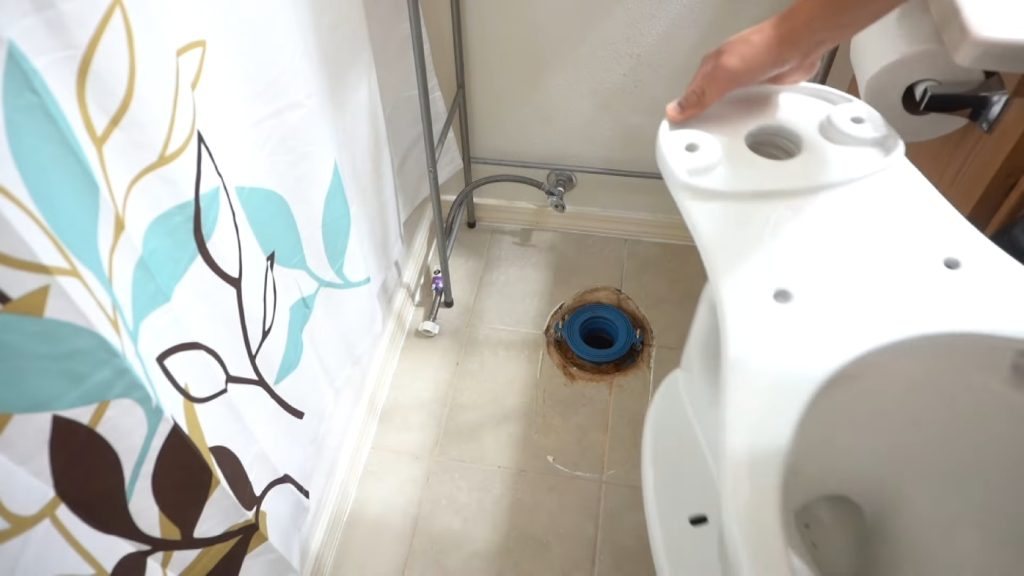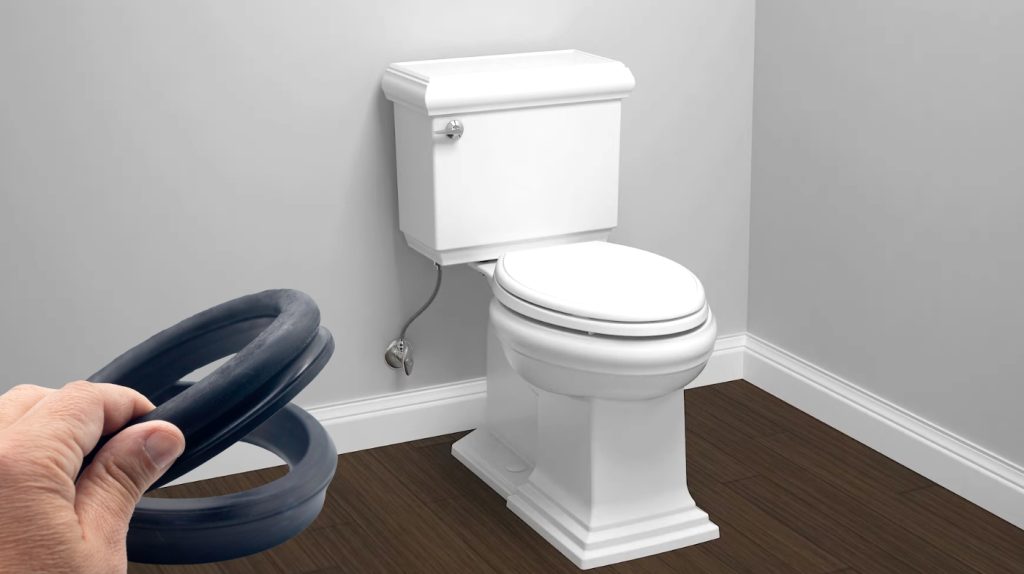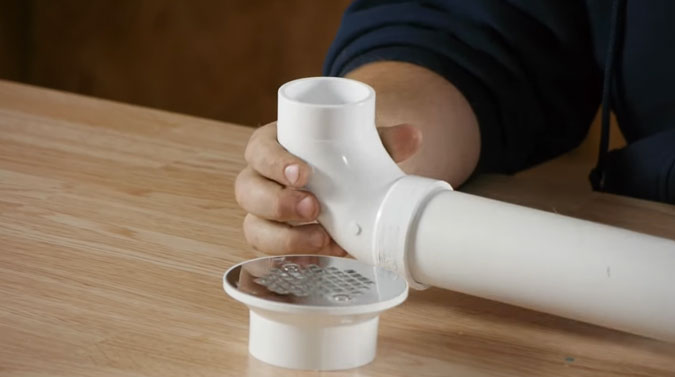Last Updated on February 16, 2025
To replace a Kohler toilet gasket, start by turning off the water supply and flushing the toilet to empty the tank. Remove the tank lid, then detach the old gasket and flapper. Install a new Kohler gasket, guaranteeing it’s flush with the tank.
Reassemble the components, reattach the fill tube, and guarantee proper chain connection. Turn the water back on and test for leaks. Continue exploring the process for detailed steps and troubleshooting tips.
Key Takeaways
- Turn off the water supply and flush the toilet to empty the tank before starting the gasket replacement process.
- Remove the old gasket by disconnecting the flapper and unscrewing nuts holding the mechanism in place.
- Clean the area thoroughly before installing the new Kohler gasket, ensuring it sits flush to prevent leaks.
- Reassemble the components, reconnecting the flush handle chain with a slight slack for smooth operation.
- Turn the water supply back on, test for leaks, and ensure proper tank refilling after flushing.
Tools and Parts Needed for Replacement
When you’re ready to replace the gasket in your Kohler toilet, having the right tools and parts on hand is crucial for a smooth process.
You’ll need a Kohler Flush Valve Seal Gasket, which you can find at Home Depot, or a universal flush valve seal kit like the Korky. For specific models, verify you have the correct part number, such as GP1059291. It’s essential to ensure proper disposal of the old gasket to maintain a clean workspace.
Don’t forget gasket lubricant to enhance durability. As for tools, grab an adjustable wrench for plumbing parts, needle-nose pliers for small components, and a basin wrench for supply lines.
Wear gloves to handle potentially contaminated parts, and have cloths or paper towels ready to clean the area. Having these items ready will streamline your gasket replacement.
Shutting Off the Water Supply
Turning off the water supply is a critical first step in replacing the gasket in your Kohler toilet.
Locate the shutoff valve, typically found under the toilet or at a wall valve. Identify the type of valve—either a ball valve, compression valve, or gate valve. Main water valves are essential for controlling water flow throughout the home.
To shut off the water, turn the valve clockwise. After the valve is off, flush the toilet to confirm the tank is empty. Check for accessibility, confirming the valve can be operated easily in emergencies. If necessary, use the main shutoff nearby.
Always verify the valve’s condition, looking for corrosion or wear. Shutting off the water supply is essential to prevent leaks during the replacement process.
Finally, be prepared with a bucket to catch any residual water when disconnecting the supply line.
Removing the Old Gasket
To remove the old gasket from your Kohler toilet, start by locating its position, typically found around the flush valve or between the tank and bowl.
Before proceeding, make sure you have the necessary tools at hand, such as a wrench and pliers. It’s important to note that Plbg.com provides valuable resources for plumbing-related education and information.
Follow these steps:
- Remove the flapper: Lift or detach the flapper to gain access to the gasket area.
- Disconnect related parts: Remove any chains or links connecting the flush handle to the flushing mechanism.
- Physically remove the gasket: Carefully unscrew any nuts holding the mechanism and pull or slide the old gasket out.
Inspect the area after removal, making certain it’s clean and free of debris before moving on to the next steps.
Installing the New Gasket
When installing the new gasket, start by selecting a genuine KOHLER part to verify compatibility and performance. Position the gasket correctly at the bottom of the tank, and secure it by inserting the plugs into the designated holes.
Finally, align the tank bolts with the bowl’s holes to assure a secure fit before fastening. Additionally, ensure that the gasket is flush with the tank surface to prevent leaks during operation.
Gasket Selection Criteria
Choosing the right gasket for your Kohler toilet is vital for guaranteeing a proper seal and preventing leaks. Keep these selection criteria in mind:
- Compatibility: Use genuine Kohler parts specific to your toilet type—whether it’s one-piece or two-piece, and consider unique requirements for models like Wellworth or Cimarron.
- Material Quality: Opt for durable materials that resist chemical exposure and prevent leaks effectively. Premium materials guarantee longevity and performance. Additionally, ensure the gasket is designed to withstand a faulty toilet valve to enhance its effectiveness.
- Flush Valve Type: Identify your toilet’s flush valve system, as gaskets differ between canister and traditional designs; selecting the right one is imperative.
Proper Installation Techniques
Proper installation of the new gasket is essential for guaranteeing an effective seal and preventing leaks in your Kohler toilet.
Begin by positioning the new gasket at the bottom of the toilet tank, and aligning it precisely with the flush valve hole. Ensure the gasket is flush with the tank’s base to avoid leaks.
Additionally, turn off the water supply before starting the installation to prevent any accidental flooding. Next, insert the flush valve into its designated hole and hand-tighten the mounting nut to secure it. Use pliers for an additional quarter turn, but avoid over-tightening.
Once the flush valve is in place, lower the tank onto the bowl, ensuring proper alignment with the holes. This careful approach sets the foundation for a reliable installation that minimizes the risk of future leaks.
Ensuring Secure Fit
A secure fit is essential for the longevity and efficiency of your Kohler toilet. Start by positioning the new gasket correctly on the bottom of the tank to align with the bowl. Make certain the flush valve washer is aligned over the flush valve before securing it with the mounting nut.
Follow these steps for ideal installation:
- Hand-tighten the mounting nut: Begin with your hand to avoid over-tightening.
- Use adjustable joint pliers: Tighten an additional quarter turn for a secure fit.
- Check for even compression: Make certain the tank-to-bowl gasket is compressed evenly to prevent leaks. Additionally, ensure that the water level remains below the top edge of the flush valve to avoid continuous running.
Regularly inspect for leaks post-installation to maintain performance.
Reassembling Toilet Components

Now that you’ve installed the new gasket, it’s time to reassemble the toilet components. Start by reattaching the fill tube to its original position, ensuring it’s secure.
Check that the flush valve gasket is properly aligned before proceeding. Next, reconnect the chain to the flush handle and position the center support for proper alignment.
Reattach Fill Tube
To successfully reattach the fill tube, start by ensuring all components are clean and free from mineral buildup that could hinder the reassembly process. Inspect the fill tube, fill valve, and surrounding components for any damage.
Confirm that the water supply line is securely attached and not leaking.
- Nut Removal: Remove any nuts or clips holding the old fill tube.
- Fill Tube Connection: Attach the new fill tube to the fill valve, ensuring a secure fit.
- Tightening the Nut: Secure the fill tube using the appropriate nut or clip, but avoid over-tightening. It is also essential to ensure that the water supply is connected properly to avoid any leaks during operation.
Once everything is in place, double-check the positioning of the fill valve for proper function before moving on to the next steps.
Secure Chain Connection
Securing the chain connection is essential for guaranteeing your toilet functions properly after replacing the gasket. Start by turning off the water supply and draining the tank. Remove the tank lid to access the components inside.
Use pliers to disconnect the old chain from the handle and flapper, then attach the new chain securely to both. It’s critical to adjust the chain length, allowing about half an inch of slack to prevent the flapper from closing prematurely or floating.
Once installed, turn on the water supply and flush the toilet to test the new chain connection. Proper chain installation is vital to ensure that the toilet flushes efficiently without any issues.
Make any necessary adjustments to guarantee efficient flushing and eliminate issues like constant running or incomplete flushes.
Position Center Support
Positioning the center support correctly is essential for ensuring the stability of your Kohler toilet after replacing the gasket. A misaligned center support can lead to movement and potential leaks, so pay attention to this step.
Here’s how to do it:
- Align the Center Support: Position the center support directly over the base of the toilet, ensuring it fits snugly.
- Check for Level: Gently press down to check that the support remains level; adjust if necessary.
- Secure the Connection: Tighten any bolts or fasteners to secure the center support in place, preventing future wobbling. Closet bolts are crucial in this process as they help anchor the toilet securely to the flange, enhancing stability.
Once you’ve completed these steps, your toilet should be stable and ready for testing. Flush several times to confirm everything functions properly.
Final Testing and Adjustments
Once you’ve replaced the gasket, conduct thorough final testing and adjustments to guarantee everything functions correctly.
First, turn the water supply back on and test flush several times to check for leaks. Inspect the alignment of the flapper and chain to verify they function smoothly.
Verify that the toilet tank refills properly after each flush. Confirm the gasket sits snugly and is fully seated without gaps. Additionally, ensure that the fill valve is operating correctly to maintain the tank water level.
Check all connections for security and alignment; components should move freely without obstruction. Use food coloring in the tank water to detect leaks, and monitor the toilet for any unusual sounds or water spots around the base.
Finally, verify the flapper closes correctly and that the toilet stops filling at the appropriate water level.
Troubleshooting Potential Issues
While replacing the gasket in your Kohler toilet, you may encounter several potential issues that could affect performance. Addressing these concerns promptly is vital for a successful repair.
Here are some common issues:
- Incorrect gasket size: Using a gasket that doesn’t fit can lead to leaks. Always verify compatibility with your model.
- Improperly seated components: Confirm all parts are aligned and securely seated during reassembly to prevent malfunctions. A common issue arises from the gasket issue under the tank that can cause leaks if not addressed correctly.
- Leakage post-replacement: If leaks persist, inspect the gasket placement and check for any damaged seals or connections.
Frequently Asked Questions
How Often Should I Replace My Toilet Gasket?
You don’t need to replace your toilet gasket regularly unless you notice signs of wear or leakage. Look for water seeping from under the toilet, unpleasant odors, or visible cracks in the gasket.
If your toilet wobbles or feels unstable, that could also indicate a problem. Generally, as long as the seal remains intact and functions well, you can skip routine replacements and only address issues as they arise.
Can I Use a Standard Gasket for a Kohler Toilet?
Using a standard gasket on a Kohler toilet is like trying to fit a square peg in a round hole; it likely won’t work. Standard gaskets often lack the compatibility required for Kohler’s specific designs, leading to leaks or improper sealing.
Instead, opt for gaskets specifically designed for Kohler models, such as Korky or original Kohler seals, to guarantee durability and a proper fit, safeguarding your toilet’s performance. Always check compatibility before purchasing.
What Signs Indicate a Faulty Toilet Gasket?
You’ll notice several signs indicating a faulty toilet gasket. Look for visible leaks, such as water pooling around the base or persistent dampness. If your toilet flushes weakly or runs constantly, that’s another red flag.
Additionally, pay attention to any sewer odors or if the toilet rocks when you use it. Regularly inspecting for discoloration or wear can help you catch gasket issues before they escalate.
Is Professional Help Necessary for Gasket Replacement?
Imagine a leaky faucet, dripping and causing frustration. You might wonder if you need professional help with gasket replacement.
For most, it isn’t necessary. If you’re comfortable with basic plumbing tasks, you can tackle them yourself. Just make certain you have the right tools and materials.
However, if you’re unsure or encounter complications, don’t hesitate to call a plumber. They can save you time and hassle, guaranteeing a proper fix.
How Long Does the Gasket Replacement Process Take?
Gasket replacement typically takes about five minutes for those experienced in the task. If you’re new to it, expect to spend a bit longer as you familiarize yourself with the steps involved.
The process is straightforward and doesn’t require specialized skills or tools, allowing you to address leaks or flushing issues quickly.
Just guarantee you’ve turned off the water supply and emptied the tank before starting to streamline your efforts.
Ensure a Leak-Free Seal with a Simple Gasket Replacement
By replacing your Kohler toilet gasket, you guarantee a leak-free seal, restore functionality, and enhance your toilet’s efficiency. You’ll gain peace of mind, enjoy a cleaner bathroom, and prevent water waste.
Remember to check for leaks after reassembly, adjust the components if needed, and troubleshoot any issues that arise.
With these steps, you’re equipped to maintain your toilet effectively, guaranteeing it operates smoothly for years to come. Embrace the satisfaction of a job well done.


